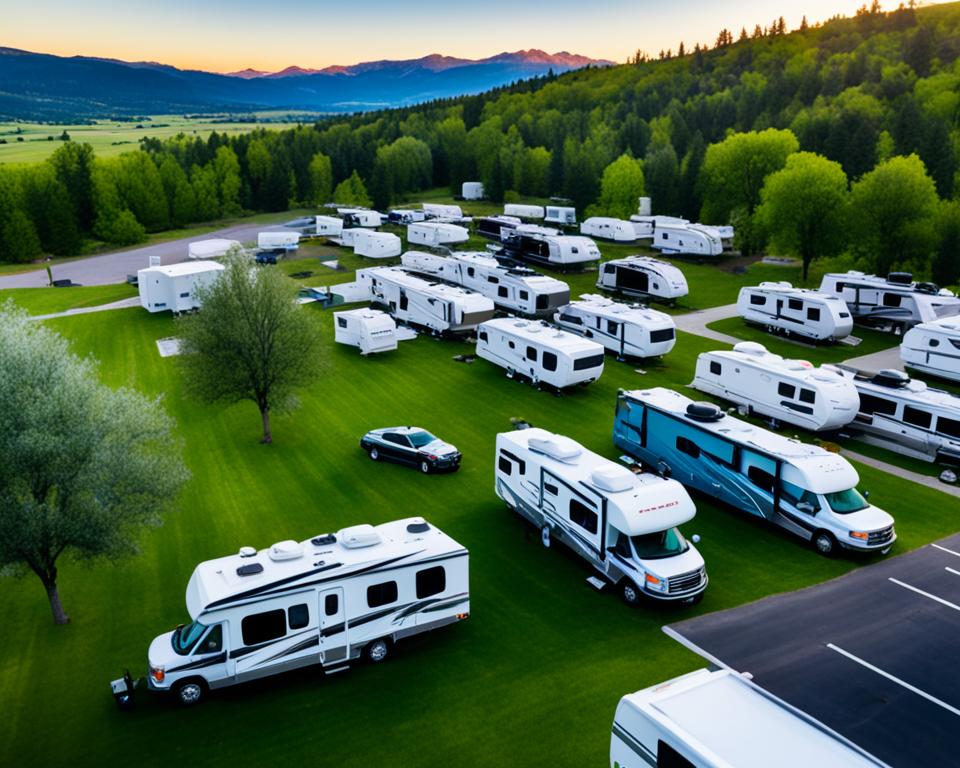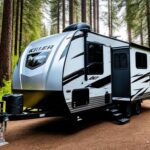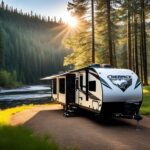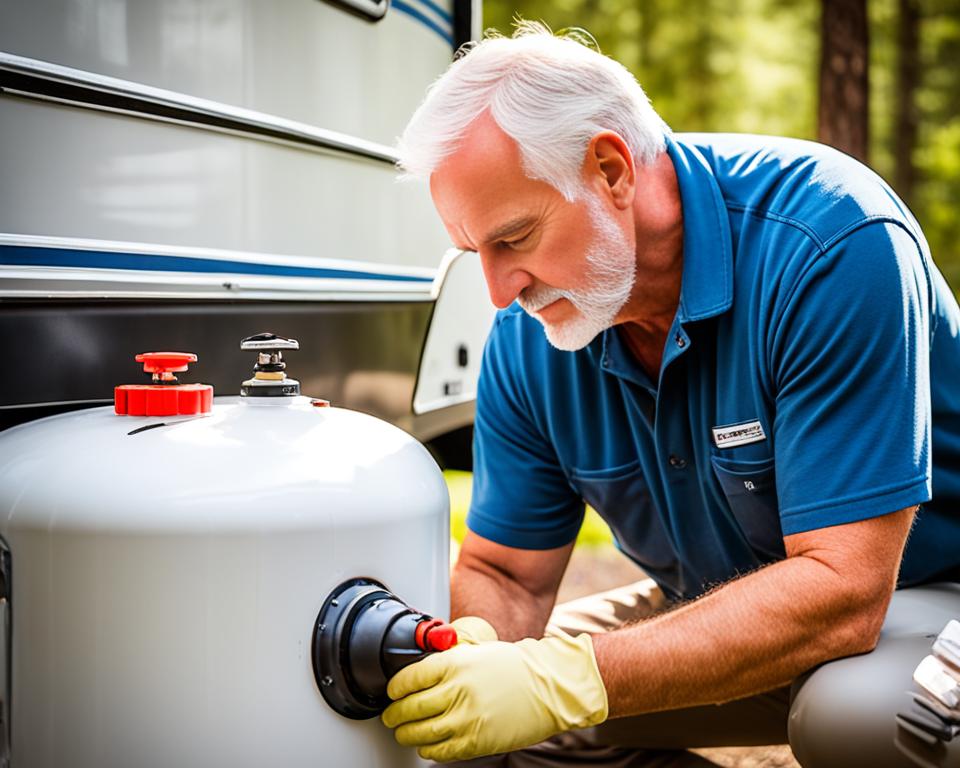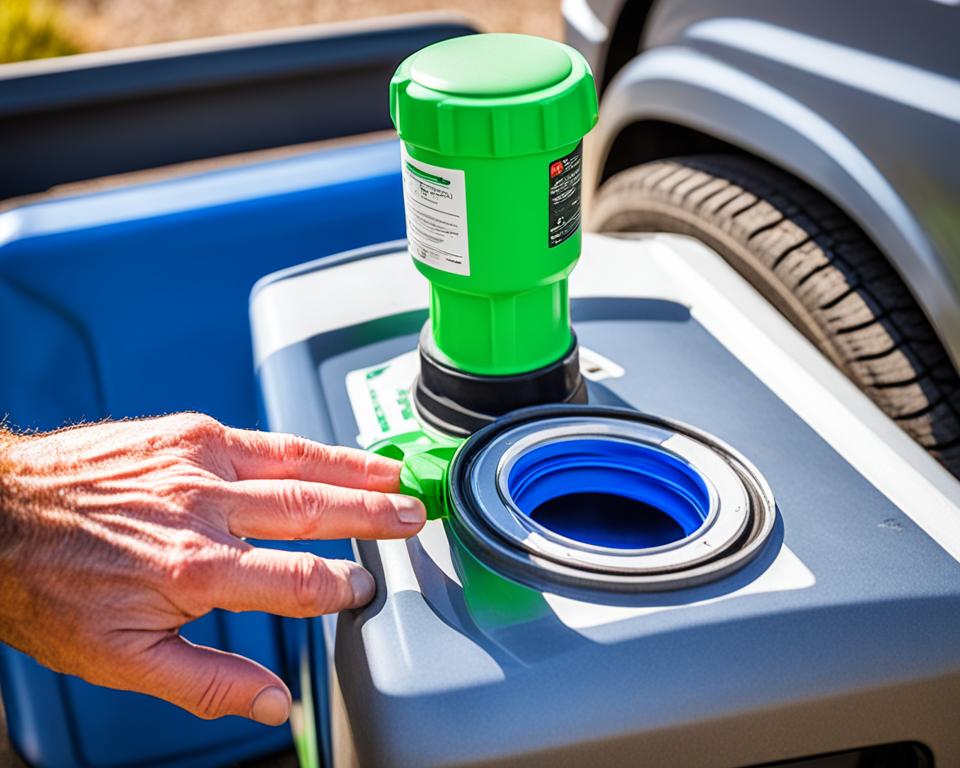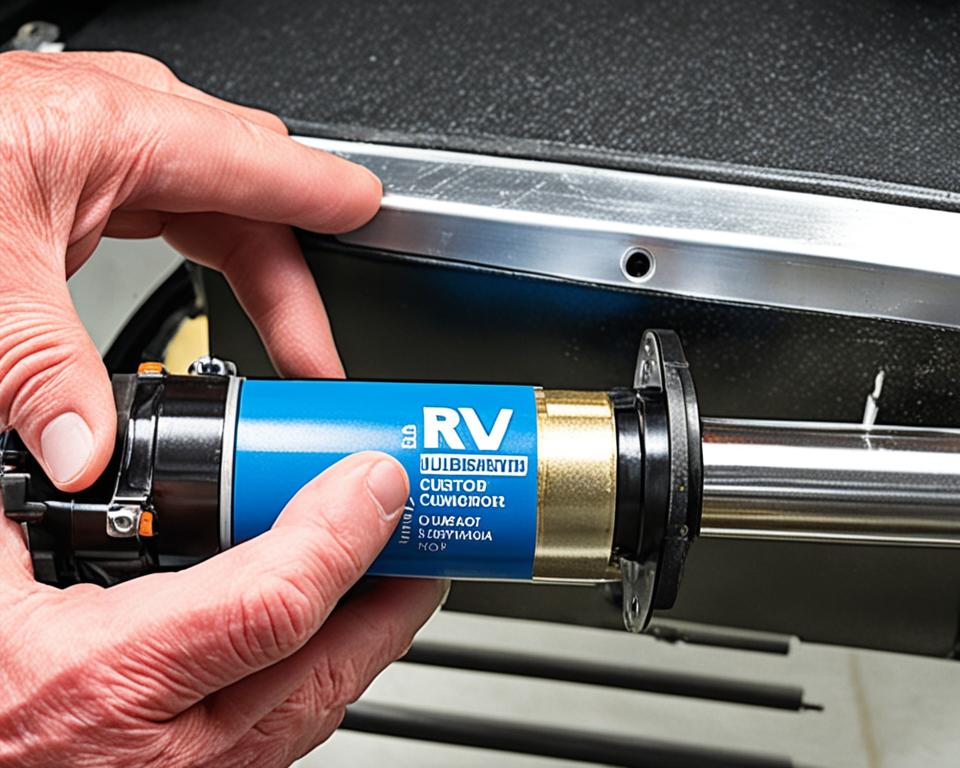Maintaining a healthy RV roof is crucial for the longevity and performance of your motorhome. Neglected roofs can lead to water damage and mold, which are not typically covered by warranties. To keep your roof in great shape, follow these RV roof maintenance tips and best practices for avoiding damage.
Routine care and maintenance can prevent costly repairs and extend the lifespan of your RV roof. Regular inspections, cleaning, and sealing are essential to protect your investment and ensure a leak-free travel experience.
Here are some key tips to keep in mind:
Key Takeaways:
- Regularly inspect your RV roof for any signs of damage, including leaks, cracks, or loose seals.
- Clean your RV roof several times a year using non-abrasive cleaners and avoid using petroleum solvents or abrasives.
- Use specific maintenance products and materials that are compatible with your RV roof material (such as rubber, fiberglass, or aluminum).
- Apply fresh sealant regularly to prevent water leaks and maintain the integrity of your roof.
- During storage, protect your RV roof from the elements by using an RV cover or storing it in a dedicated RV storage facility.
By following these essential RV roof maintenance tips, you can ensure that your roof stays in optimal condition, providing a safe and comfortable travel experience for years to come.
Best Materials for RV Roofs
RVs come with a variety of roof materials to suit different needs and preferences. Here, we’ll explore the best options for RV roofs, including rubber, fiberglass, and aluminum.
Rubber Roofs (TPO and EPDM)
Rubber roofs, particularly TPO (Thermoplastic Olefin) and EPDM (Ethylene Propylene Diene Monomer), are popular choices for RV owners. They offer several advantages, including:
- Cost-efficiency: Rubber roofs are typically more affordable compared to other materials.
- Resistance to dirt and mold: Rubber roofs are resistant to dirt buildup and mold growth, making them easier to clean and maintain.
- Energy efficiency: Rubber roofs reflect sunlight, reducing the heat absorbed into the RV and improving energy efficiency.
However, it’s important to note that rubber roofs may require more frequent maintenance, and they may not handle direct sun exposure as well as other materials.
Fiberglass Roofs
Fiberglass roofs are another popular choice among RV owners due to their lightweight nature and durability. They offer the following benefits:
- Lightweight: Fiberglass roofs are significantly lighter than other materials, helping to reduce overall RV weight.
- Customizability: Fiberglass allows for greater design flexibility, enabling RV owners to customize their roofs according to their preferences.
- Durability: Fiberglass roofs are known for their strength and durability, providing long-lasting protection against harsh weather conditions.
However, fiberglass roofs can be prone to oxidation and thermal splits, which may require maintenance and repairs over time.
Aluminum Roofs
Although less common, some RVs feature aluminum roofs, which offer unique advantages:
- Longevity: Aluminum roofs are known for their exceptional longevity, with the potential to outlast other materials.
- Strength: Aluminum roofs are highly resistant to impact and can withstand harsh weather conditions.
However, it’s important to note that aluminum roofs may require proper fastening techniques during installation to prevent issues like seam failure.
Choosing the right material for your RV roof depends on factors such as budget, maintenance preferences, and desired durability. Consider these options carefully to select the best roof material that suits your specific needs.
| Roof Material | Advantages | Disadvantages |
|---|---|---|
| Rubber (TPO and EPDM) | – Cost-efficient | – May require more frequent maintenance |
| Fiberglass | – Lightweight | – Prone to oxidation and thermal splits |
| Aluminum | – Longevity | – Requires proper fastening techniques |
Image:
Proper Installation for RV Roofs
Regardless of the roof material, proper installation is crucial for a strong and durable roof. It’s recommended to either follow the manufacturer’s installation instructions carefully or hire a professional for the job. Additionally, it’s important to source your materials from reputable manufacturers to ensure the best quality product.
When it comes to RV roof installation, precision and expertise are key. One small mistake during the installation process can lead to significant issues down the road, such as leaks or structural damage. That’s why it’s advisable to rely on professionals who have experience in RV roof installation. They have the necessary skills and knowledge to handle the intricacies of the installation process, ensuring that your roof is properly secured and sealed.
Moreover, hiring professionals for your RV roof installation gives you peace of mind knowing that the job will be done correctly and efficiently. They are well-versed in the specific requirements of different roof materials, allowing them to determine the best installation methods for your RV. Their expertise minimizes the risk of costly mistakes and maximizes the longevity of your roof.
When selecting materials for your RV roof installation, it’s essential to choose reputable manufacturers. Trusted manufacturers have a proven track record of producing high-quality and durable roofing materials. By opting for products from reputable manufacturers, you can have confidence in the reliability and performance of your RV roof.
Investing in professional RV roof installation and sourcing materials from reputable manufacturers ensures that your roof is in capable hands. A well-installed roof will provide lasting protection and structural integrity, giving you peace of mind during your travels.
Benefits of Professional RV Roof Installation:
- Expertise in handling different roof materials
- Precise and accurate installation methods
- Minimized risk of leaks and structural damage
- Efficient installation process
- Peace of mind knowing the job is done correctly
Top Reputable Manufacturers for RV Roofing Materials
| Manufacturer | Specialization |
|---|---|
| Dicor Corporation | Rubber and fiberglass roofing |
| Alpha Systems | Rubber roofing |
| Lippert Components | Fiberglass roofing |
| Duo-Form Plastics | Fiberglass and aluminum roofing |
Regular RV Roof Maintenance & Repair Tips
Regular maintenance is vital to keep all types of RV roofs in optimal condition. Manufacturers typically recommend preventative maintenance every three months to prevent potential issues. By following these essential tips for RV roof maintenance and repair, you can ensure the longevity and performance of your motorhome.
Supplies for RV Roof Repair
Having the right supplies on hand is crucial for effective RV roof repairs. Here are some essential items to stock up on:
- Roof sealant
- Primer
- Caulk
- Seam roller
- Roof patches
- Roof cleaner
It is important to ensure that these supplies are specific to your RV roof material to achieve the best results.
Routine Cleaning and Inspection
Regularly cleaning and inspecting your RV roof are essential for its maintenance. Follow these steps:
- Use a non-abrasive roof cleaner to remove dirt and debris.
- Gently scrub the roof surface using a soft brush or sponge.
- Rinse the roof thoroughly with clean water.
- Inspect the roof seams for any signs of damage, such as tears or gaps.
- Ensure the sealant around vents, skylights, and other openings is intact.
Regularly cleaning and inspecting your RV roof will help identify any issues early and prevent them from becoming more significant problems.
In your RV roof inspection, pay close attention to areas that are prone to dirt accumulation, such as the skylights, AC unit, vents, ladder, and roof rack.
Patching and Repairing Rips or Tears
In the event of any rips or tears in your RV roof, it is crucial to address them immediately to prevent further damage. Here’s what you need to do:
- Clean the damaged area with a roof cleaner and let it dry completely.
- Apply roof patching material over the damaged area, ensuring it covers the full extent of the rip or tear.
- Press the patch firmly to secure it in place.
- Smooth out any air bubbles using a seam roller.
Preventative Maintenance
Preventative maintenance plays a significant role in extending the lifespan of your RV roof. In addition to regular cleaning and inspection, consider the following tips:
Regularly apply a fresh layer of roof sealant to protect the roof surface and prevent leaks.
Invest in a caulking gun to easily apply sealant to the necessary areas, ensuring a proper seal.
Cleaning and Inspection of RV Roof
Regular maintenance of your RV roof is essential to ensure its appearance and longevity. Cleaning your roof several times a year, especially if it’s made of rubber, will help keep it in top condition. Non-abrasive cleaners are recommended, as they effectively remove dirt and grime without causing damage.
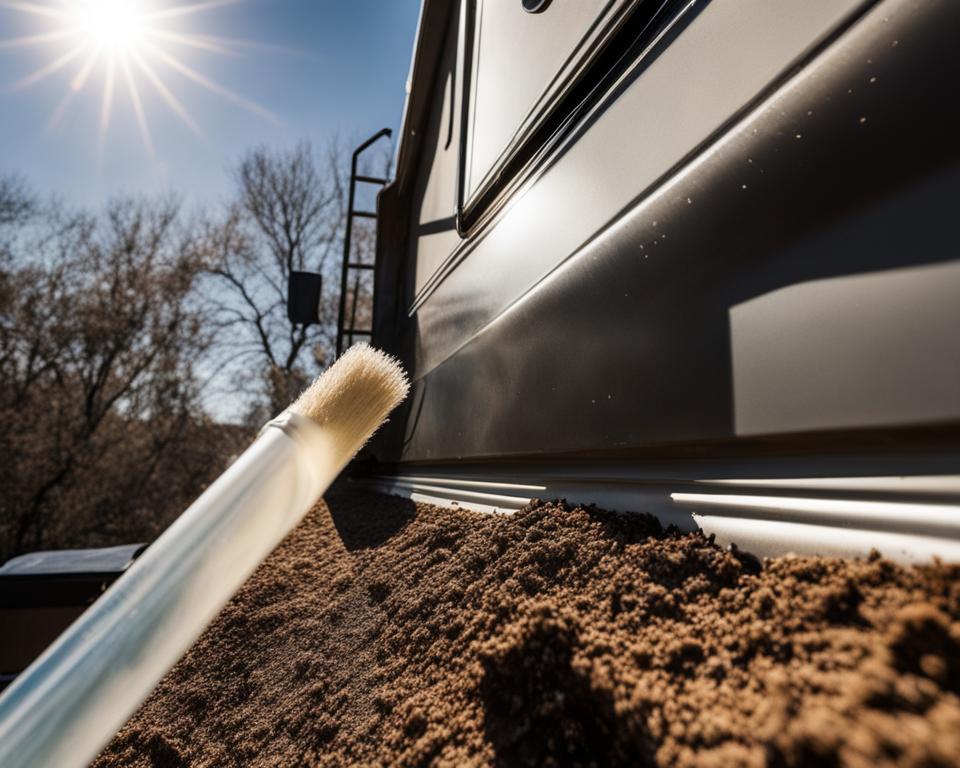
“Regular cleaning should be accompanied by a thorough inspection of seams and sealants.”
During the cleaning process, pay special attention to areas that are prone to dirt, mold, and cracks, such as skylights, AC units, vents, ladders, and the roof rack. Inspecting these areas will allow you to identify any potential issues before they worsen.
Recommended Cleaning Steps:
- Gently sweep away loose debris and leaves from the roof surface.
- Prepare a solution of non-abrasive cleaner and water as per the manufacturer’s instructions.
- Using a soft-bristle brush or a sponge, apply the cleaner to the roof surface, working in small sections.
- Gently scrub the surface in a circular motion to remove dirt and stains.
- Rinse thoroughly with a hose, ensuring all cleaner residue is removed.
- Allow the roof to air dry completely before moving on to the inspection process.
Inspecting Seams and Sealants:
- Check the condition of all seams and sealants for any signs of cracks, gaps, or deterioration.
- Pay close attention to areas around skylights, vents, and other protrusions.
- If you notice any damage or wear, make prompt repairs using suitable roof repair products.
By regularly cleaning and inspecting your RV roof, you can catch potential issues early on and prevent more significant problems down the road. Taking proactive measures will help extend the lifespan of your roof and ensure a comfortable and leak-free journey.
Resealing and Recoating RV Roof
Keeping your RV roof well-maintained is essential for its longevity and to prevent leaks. Even if there are no visible issues, it’s recommended to apply fresh sealant regularly. Some experts advise resealing and recoating RV roofs annually to ensure maximum protection. Using products specifically designed for your roof material is crucial to guarantee optimal performance.
By resealing and recoating your RV roof, you create an additional layer of protection against the elements, including UV rays, water damage, and potential leaks. This preventative measure can significantly extend the lifespan of your roof and save you from costly repairs down the road.
When choosing products, consider factors such as compatibility with your roof material and climate conditions. There are various roof sealants and coatings available for different roof types, including rubber, fiberglass, and aluminum. Pay attention to manufacturer recommendations and follow their instructions for best results.
Proper application is key when resealing and recoating your RV roof. Ensure that the surface is clean, dry, and free from any loose material before applying the sealant or coating. Use a suitable applicator, such as a paint roller or brush, to evenly distribute the product. Allow sufficient drying time before exposing your RV to any moisture or extreme weather conditions.
Benefits of Resealing and Recoating
There are several benefits to resealing and recoating your RV roof:
- Enhanced protection against water leaks
- Extended lifespan of the roof
- Prevention of damage caused by UV rays
- Improved insulation and energy efficiency
- Preservation of the roof’s appearance
Regular resealing and recoating are key maintenance tasks that should not be overlooked. By investing time and effort in this crucial step, you can ensure the long-term durability and performance of your RV roof.
RV Roof Damage Prevention
Preventing damage to your RV roof is essential, particularly during storage. By taking the necessary precautions, you can protect your roof from the elements and ensure its longevity. Here are some effective ways to prevent RV roof damage:
RV Storage
When storing your RV, it’s important to choose a secure and suitable facility that provides protection from the sun, rain, and hail. Look for a reputable RV storage facility that offers covered or enclosed options to shield your RV from potential roof damage.
Roof Cover
Another option for safeguarding your RV’s roof is to use a dedicated roof cover. These covers are designed specifically for RVs and provide an extra layer of protection against UV rays, rain, and other environmental factors. A well-fitted roof cover can help prevent water damage and minimize sun-related wear and tear.
It’s worth noting that using other types of tarps or covers not designed for RVs may trap moisture, leading to mold and mildew growth. To ensure optimal protection, invest in a high-quality RV roof cover.
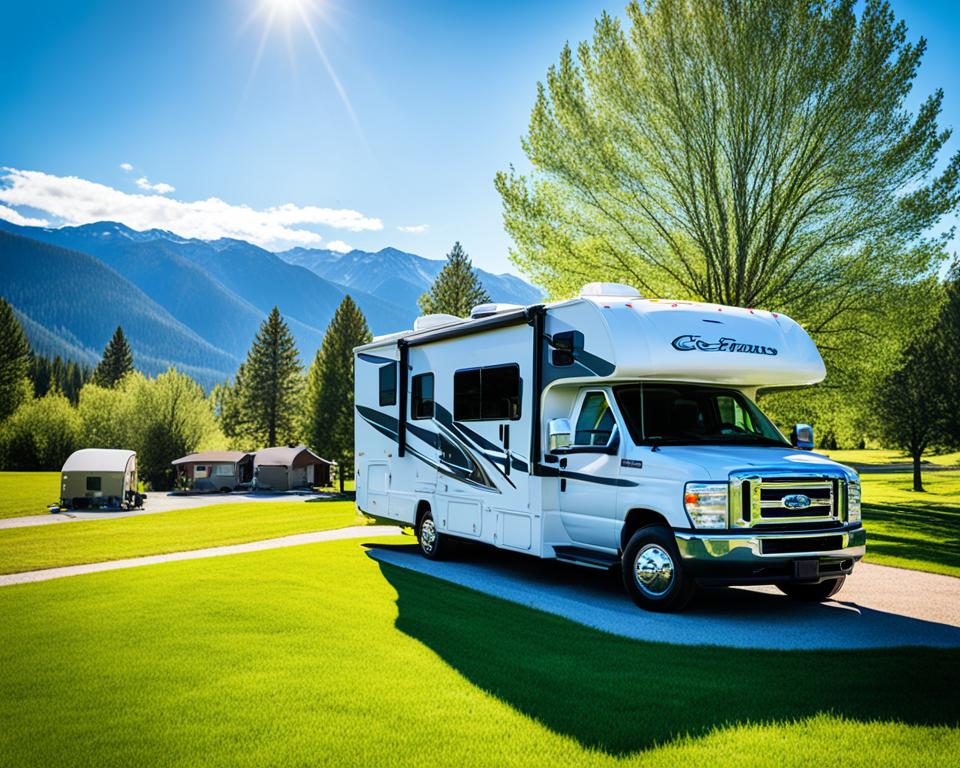
“Investing in a secure RV storage facility or using a roof cover designed specifically for RVs can significantly reduce the risk of roof damage and extend the lifespan of your RV.”
By implementing these preventive measures, you can minimize the risk of roof damage and preserve the condition of your RV. Whether it’s storing your RV in a reputable facility or utilizing a dedicated roof cover, prioritizing RV roof protection is essential for maintaining the integrity of your vehicle.
Conclusion
Proper RV roof maintenance is vital to ensure the longevity and performance of your motor home. By following these RV roof care tips, including regular cleaning, inspection, repair, resealing, and damage prevention, you can keep your roof in excellent condition. It is important to choose the right maintenance products and materials specific to your roof type to maximize its lifespan and performance.
Regular cleaning and inspection of your RV roof, paying special attention to seams and sealants, will help identify and address any potential issues before they worsen. Applying fresh sealant annually, even if there are no visible issues, provides an additional layer of protection and reduces the risk of leaks. By protecting your RV roof from the elements during storage, you can prevent water and sun damage, ensuring optimal condition.
Remember, proper RV roof maintenance is essential to protect your investment and ensure a comfortable and leak-free travel experience. With proper care and attention, your RV roof will continue to provide a safe and cozy home on the road.
FAQ
Why is maintaining an RV roof important?
Maintaining an RV roof is crucial for the longevity and performance of your motor home. Neglected roofs can lead to water damage and mold, which are not typically covered by warranties.
What are the common materials used for RV roofs?
RV roofs are commonly made from rubber (TPO or EPDM), fiberglass, or aluminum.
What are the advantages and disadvantages of rubber roofs?
Rubber roofs, like TPO and EPDM, are cost-efficient, resistant to dirt and mold, and energy efficient. However, they may need more frequent maintenance and don’t handle sun exposure as well.
What are the advantages and disadvantages of fiberglass roofs?
Fiberglass roofs are lightweight, customizable, and durable but can be prone to oxidation and thermal splits.
What are the advantages and disadvantages of aluminum roofs?
Aluminum roofs are rare but known for their longevity, although they may require fastening and are susceptible to seam failure.
How important is proper installation for an RV roof?
Proper installation is crucial for a strong and durable roof. It’s recommended to either follow the manufacturer’s installation instructions carefully or hire a professional for the job.
What is the recommended frequency for RV roof maintenance?
Most manufacturers suggest preventative maintenance every three months.
What are the common supplies needed for RV roof repair?
Common repair supplies include sealant, primer, caulk, seam roller, roof patches, and roof cleaner. These supplies should be specific to your roof material.
How often should I clean my RV roof?
RV roofs, especially rubber ones, should be cleaned several times a year to maintain appearance and longevity.
What products should I avoid when cleaning an RV roof?
Petroleum solvents, abrasives, and citrus ingredients should be avoided when cleaning an RV roof.
Should I apply sealant even if there are no visible issues with my RV roof?
Yes, applying fresh sealant is recommended even if there are no visible issues. Some experts advise resealing and recoating RV roofs annually.
How can I prevent roof damage to my RV during storage?
Storing your RV in an RV storage facility or using a roof cover designed for RVs can protect it from the sun, rain, and hail.

